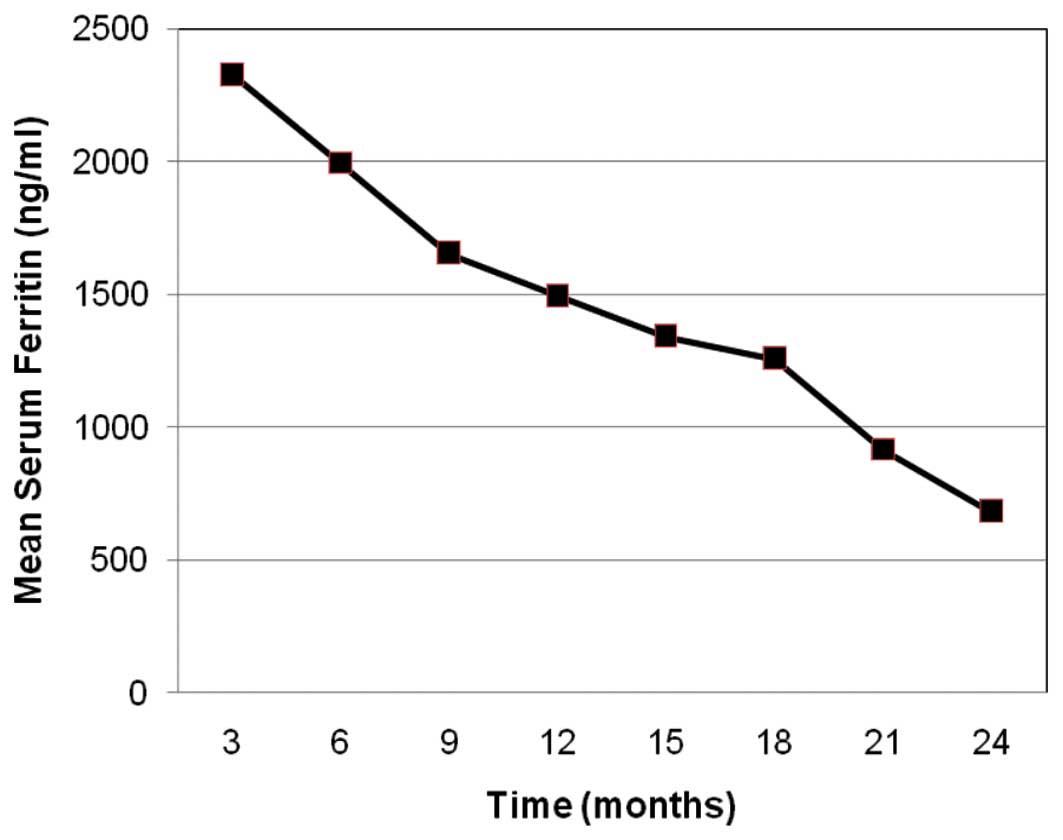|
1
|
Neukirchen J, Fox F, Kündgen A, Nachtkamp
K, Strupp C, Haas R, Germing U and Gattermann N: Improved survival
in MDS patients receiving iron chelation therapy - a matched pair
analysis of 188 patients from the Düsseldorf MDS registry. Leuk
Res. 36:1067–1070. 2012.PubMed/NCBI
|
|
2
|
Dreyfus F: The deleterious effects of iron
overload in patients with myelodysplastic syndromes. Blood Rev.
22(Suppl 2): S29–S34. 2008. View Article : Google Scholar : PubMed/NCBI
|
|
3
|
Malcovati L, Porta MG, Pascutto C,
Invernizzi R, Boni M, Travaglino E, Passamonti F, Arcaini L,
Maffioli M, Bernasconi P, et al: Prognostic factors and life
expectancy in myelodysplastic syndromes classified according to WHO
criteria: a basis for clinical decision making. J Clin Oncol.
23:7594–7603. 2005. View Article : Google Scholar
|
|
4
|
Delea TE, Hagiwara M and Phatak PD:
Retrospective study of the association between transfusion
frequency and potential complications of iron overload in patients
with myelodysplastic syndrome and other acquired hematopoietic
disorders. Curr Med Res Opin. 25:139–147. 2009. View Article : Google Scholar
|
|
5
|
Toma A, Fenaux P, Dreyfus F and Cordonnier
C: Infections in myelodysplastic syndromes. Haematologica.
97:1459–1470. 2012. View Article : Google Scholar : PubMed/NCBI
|
|
6
|
Rose C, Brechignac S, Vassilief D, et al:
Does iron chelation therapy improve survival in regularly
transfused lower risk MDS patients? A multicenter study by the GFM
(Groupe Francophone des Myélodysplasies). Leuk Res. 34:864–870.
2010.PubMed/NCBI
|
|
7
|
Komrokji RS, Al Ali NH, Padron E, Lancet
JE and List AF: Impact of iron chelation therapy on overall
survival and AML transformation in lower risk MDS patients treated
at the Moffitt Cancer Center. Blood (ASH Annual Meeting Abstracts).
118:27762011.
|
|
8
|
Lyons RM, Marek BJ, Paley C, et al:
Relationship between chelation and clinical outcomes in 600
lower-risk MDS ratients: registry analysis at 36 months. Blood (ASH
Annual Meeting Abstracts). 120:38002012.
|
|
9
|
de Swart L, Smith A, Fenaux P, et al:
Early mortality in 1000 newly diagnosed MDS patients with low- and
intermediate-1 risk MDS in the European Leukemianet MDS (EUMDS)
registry. Blood (ASH Annual Meeting Abstracts). 120:38302012.
|
|
10
|
Santini V, Alessandrino PE, Angelucci E,
Barosi G, Billio A, Di Maio M, et al: Clinical management of
myelodysplastic syndromes: update of SIE, SIES, GITMO practice
guidelines. Leuk Res. 34:1576–1588. 2010. View Article : Google Scholar : PubMed/NCBI
|
|
11
|
Arboretti R, Tognoni G and Alberti D:
Italian Colaborative Group on Thalassarmia Pharmacosurveillance and
quality of care of thalassaemic patients. A large scale
epidemiological survey. Eur J Clin Pharmacol. 56:915–922. 2001.
View Article : Google Scholar
|
|
12
|
Cappellini MD and Piga A: Current status
in iron chelation in hemoglobinopathies. Curr Mol Med. 8:663–674.
2008. View Article : Google Scholar : PubMed/NCBI
|
|
13
|
Galanello R, Campus S and Origa R:
Deferasirox: pharmacokinetics and clinical experience. Expert Opin
Drug Metab Toxicol. 8:123–134. 2012. View Article : Google Scholar : PubMed/NCBI
|
|
14
|
List AF, Baer MR, Steensma DP, Raza A,
Esposito J, Martinez-Lopez N, et al: Deferasirox reduces serum
ferritin and labile plasma iron in RBC transfusion dependent
patients with myelodysplastic syndrome. J Clin Oncol. 30:2134–2139.
2012. View Article : Google Scholar : PubMed/NCBI
|
|
15
|
Gattermann N, Finelli C, Della Porta M, et
al: Hematologic responses to deferasirox therapy in
transfusion-dependent patients with myelodysplastic syndromes.
Haematologica. 97:1364–1371. 2012. View Article : Google Scholar : PubMed/NCBI
|
|
16
|
Angelucci E, Santini V, Di Tucci AA, et
al: Deferasirox chelation therapy in transfusion dependent MDS
patients. Final report from the GIMEMA MDS0306 prospective trial.
Blood (ASH Annual Meeting Abstracts). 120:4252012.
|
|
17
|
Guariglia R, Martorelli MC, Villani O,
Pietrantuono G, Mansueto G, D’Auria F, et al: Positive effects on
hematopoiesis in patients with myelodysplastic syndrome receiving
deferasirox as oral iron chelation therapy: a brief review. Leuk
Res. 35:566–570. 2011. View Article : Google Scholar : PubMed/NCBI
|
|
18
|
Cheson BD, Greenberg PL, Bennett JM, et
al: Clinical application and proposal for modification of the
International Working Group (IWG) response criteria in
myelodysplasia. Blood. 108:419–425. 2006. View Article : Google Scholar : PubMed/NCBI
|
|
19
|
Gattermann N, Finelli C, Della Porta M, et
al: Deferasirox in iron-overloaded patients with
transfusion-dependent myelodysplastic syndromes: Results from the
large 1-year EPIC study. Leuk Res. 34:1143–1150. 2010.PubMed/NCBI
|
|
20
|
Armand P, Kim HT, Cutler CS, Ho VT, Koreth
J, Alyea EP, Soiffer RJ and Antin JH: Prognostic impact of elevated
pretransplantation serum ferritin in patients undergoing
myeloablative stem cell transplantation. Blood. 109:4586–4588.
2007. View Article : Google Scholar
|
|
21
|
Yahata T, Takanashi T, Muguruma Y, Ibrahim
AA, Matsuzawa H, Uno T, Sheng Y, Onizuka M, Ito M, Kato S and Ando
K: Accumulation of oxidative DNA damage restricts the self-renewal
capacity of human hematopoietic stem cells. Blood. 118:2941–2950.
2011. View Article : Google Scholar : PubMed/NCBI
|
|
22
|
Ghoti H, Fibach E, Merkel D, Perez-Avraham
G, Grisariu S and Rachmilewitz EA: Changes in parameters of
oxidative stress and free iron biomarkers during treatment with
deferasirox in iron-overloaded patients with myelodysplastic
syndromes. Haematologica. 95:1433–1434. 2010. View Article : Google Scholar : PubMed/NCBI
|
|
23
|
Messa E, Carturan S, Maffé C, Pautasso M,
Bracco E, Roetto A, et al: Deferasirox is a powerful NF-kappaB
inhibitor in myelodysplastic cells and in leukemia cell lines
acting independently from cell iron deprivation by chelation and
reactive oxygen species scavenging. Haematologica. 95:1308–1316.
2010. View Article : Google Scholar
|
|
24
|
Jensen PD, Jensen IM and Ellegaard J:
Desferoxamine treatment reduces blood transfusion requirements in
patients with myelodysplastic syndrome. Br J Haematol. 80:121–124.
1992. View Article : Google Scholar : PubMed/NCBI
|















